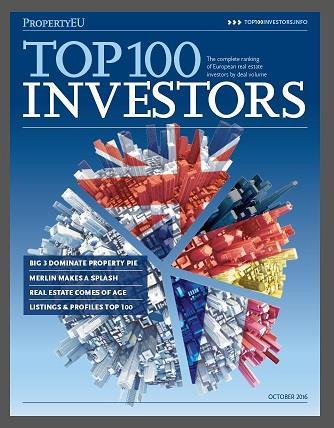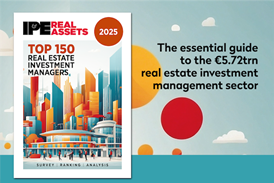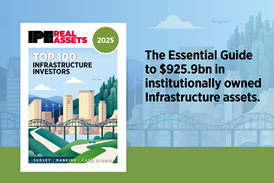Continental players have increased their clout as new sources of capital continue to target European real estate.

For the first time since we started publishing our annual ranking of the Top 100 Investors, the top 10 this year are all domiciled in Europe. Real estate investment managers affi liated to insurance companies have in particular increased their clout, accounting for no less than half – or five – of the top 10 thanks to the inclusion of Allianz Real Estate. The German company jumped seven notches to come in at number nine this year after lifting its assets under management (AUM) by 24% to €30.2 bn at end-2015.
The Top100 Investors publication is available online here for 2016
Ranking based on assets under management
As usual, the ranking of the Top100 Investors for our October edition is based on real estate AUM in Europe as at 31 December 2015 unless otherwise indicated. In March we publish our alternating Top100Investors, which is based on the biggest dealmakers in European real estate in the preceding year.
With the exception of Swiss Life, which owes its top position to the takeover of German property management company Corpus Sireo in 2014, the four real estate investment managers affiliated to insurance companies in the top 10 have boosted their AUM figures thanks to their growing real estate debt portfolios. AXA Investment Manager – Real Assets leads the pack with a total European debt portfolio of over €10 bn as at end-2015. This is equivalent to almost 20% of the total real estate portfolio.
Its UK and German peers – Aviva Investors, M&G Real Estate and Allianz Real Estate – have also significantly lifted their exposure to this segment of the asset class. The inclusion of Swiss Life in first position for the second year running may raise some eyebrows given that Corpus Sireo is not an investment manager like its parent company. That shines the light on one of the difficulties of bringing together our ranking, which cuts across both the listed and non-listed sectors and brings together birds of many different feathers.
In addition to ‘traditional’ asset managers, the ranking covers real estate investment managers linked to insurers, financial groups, and brokers as well as European and international private equity players. We also include pension funds with asset management arms that act as principals like APG, CPPIB and Norges Bank IM. Another key group is the listed real estate companies and REITs which account for roughly 25% of the total Top 100.
A good snapshot
Our reasoning for bringing together this diverse group of real estate investment managers is that it provides a good snapshot of the key players active in the market. Both listed and non-listed real estate managers – regardless of their capital source – buy and manage real estate assets on behalf of their investors, put together portfolios in a particular region or city and seek to maintain and/or add value. The legal entity in which the investment assets are structured may differ, but in terms of segments and geography the same rules apply and public and private players often find themselves competing for the same opportunities.
For the first time since we launched Top 100 Investors in 2013, CBRE Global Investors has dropped out of the top 10. We rank the firm, which is part of the world’s leading real estate advisory fi rm CBRE, as US-domiciled, despite the fact that a large chunk of its portfolio is located in Europe thanks to the merger with Amsterdam-based ING REIM in 2011. In all fairness, CBRE GI only just failed to make the grade for the top 10 and came in at 11th position with AUM of €28.7 bn, up 5% year-on-year.
CBRE GI has seen its AUM rise steadily since the merger, but other US players have seen more spectacular growth on this side of the Atlantic. Private equity giants such as Blackstone, Lone Star and Cerberus have taken the European real estate sector by storm since the outbreak of the financial crisis in their hunt for distressed assets and loan portfolios. For our part, we have been pursuing these massive players in recent years to get a grip on how their European real estate portfolios have been shaping up and are pleased to report that the Blackstone Group has for the first time agreed to participate in our annual survey. The New York-listed company has been likened to a silverback gorilla and the size of its European real estate portfolio lends credibility to that description. The group came in with a splash at 19th position this year with €23.3 bn.
Listed newcomers
Other newcomers include a string of listed real estate companies from various parts of the Continent. Madrid-based Merlin Properties is the most notable member of this group: the firm came in at number 72 after lifting its AUM by no less than 173% in the year to end-2015.
Indeed, the company is the biggest winner overall in our ranking thanks to this performance, which is attributable to the takeover of its Spanish peer Testa last year. The company, headed by Ismael Clemente, is set to rise further in the ranks next year once its planned acquisition of another domestic firm, Metrovacesa, is finalised. Another Spanish firm that made the grade this year thanks to additional desk research by our editorial team is Inmobiliaria Colonial. Like most Spanish players, the Madrid-listed company was hit hard by the crisis but has seen its AUM grow steadily in the past few years, earning it a position at number 59 with AUM of €6.9 bn.
At the top end of mainland Europe, we have included a number of Nordic players in our ranking as consolidation continues to leave its mark on the sector. Helsinki-based retail specialist Citycon was a notable entrant in our last ranking following its takeover of Norwegian peer Sektor Gruppen in early 2015. This year we have added Swedish residential specialist Balder which has almost doubled in size over the 12-month period thanks to its takeover of Finnish company Sato.
The listed real estate sector is on the whole more transparent than the non-listed sector which has enabled us to find out more about yet another gem of a company that we previously had only come across in passing: Frankfurt-based Aroundtown. Following our ‘discovery’, the company filled in our survey form and subsequently alerted us to the fact that it owns another listed legal entity, Grand City Properties. Unfortunately this additional information reached us too late for the actual ranking, but based on assets under management at end-2015, GCP would rank in equal place at number 100 alongside Heitman and Beni Stabili.
Increased professionalism
PropertyEU’s Top100Investors is a voyage of discovery and every year we aim to add new companies and more information to our database. We are happy to report that work behind the scenes on our Top100Investors app is progressing well and the official launch is set for this autumn. In other words, any companies like Grand City Properties that just missed out on this year’s ranking of the Top 100 will be entered into our database for inclusion in a real-time overview.
In this year of our 10th anniversary, increased professionalism is a theme that runs through the entire European real estate industry. Or, as Ric Lewis, CEO of Tristan Capital Partners, put it during an interview with PropertyEU, there are two key trends that deserve notice and recognition. One is the huge development of the real estate investment management (REIM) industry in Europe in terms of its growth and strength. The sector has not only survived a major lifecycle event, it has also restructured and reshaped itself throughout the global financial crisis, he points out. ‘In the past, real estate investment was channelled primarily through direct investment separate accounts or club deals. Now, when one wants to access real estate and increase the scale of exposure, there are many ways to do it: directly; in clubs, through publicly traded companies; and through real estate private equity funds, fund of funds and secondaries, among others.’
Equally, the European market is now considered a separate, distinct and established market in its own right, not a spin-off sojourn from the US market, he adds. ‘Not so many years ago, investors tended to focus their time and money on the US, with some additional international investment in Europe or Asia, but this is now a global industry with three distinct marketplaces: Europe, Asia and the US.’ All in all, there is credible evidence that the industry is mature, resilient and no longer the static and sole domain of four or five major bank-controlled managers, he notes. ‘Today, we have a diverse and diversified collection of managers of varying size, scale and specialty. The industry has “arrived” over the last decade, achieving worldwide sustainable credibility.’
Integrated business model
Other signs that the industry is maturing is the strong growth of players affiliated to local rather than US financial groups. UBS Global Asset Management, for example, has risen to 18th from 23rd position as it continues to broaden its capital base to include mandates from home-grown institutional investors such as Poste Vita and BVK. Traditionally, the company pursued a model based on what the company’s real estate head Thomas Wels describes as ‘a multi-boutique’ business. For example, the UK business dealt with UK clients while the German business focused on domestic clients via its open-ended fund operations. But in the wake of the global financial crisis it emerged that the model was no longer in tune with investor requirements and the firm has moved towards an integrated model that meets the growing demand for international diversification.
Another player that is restructuring its business in response to increased demand from both European and global investors is BNP Paribas REIM, affiliated to the eponymous French banking group. The real estate investment manager was steady in 21st position in our ranking this year with just under €22 bn, but its global head Barbara Knoflach has big ambitions. The company is targeting AUM of €30 bn and is eyeing a spot in the top five of leading non-listed European investment managers, Knoflach told PropertyEU earlier this year.
While Europe’s listed real estate sector remains a dwarf compared to its US counterpart, it has grown in size and maturity in the past decade. At the annual conference of the European Public Real Estate Association in Paris in September, we learned that MSCI and Standard & Poor’s have elevated listed real estate as a stand-alone sector in the global benchmark for equity indices. The move is significant, Alex Moss, chairman of EPRA’s Research Committee, explained during the conference. ‘This is the first time that a sector has been taken out of a broad sector. What this proves is that listed real estate is a separate asset class and deserves separate classification.’
Other signs that Europe’s listed real estate sector has progressed are the record number of companies now complying with EPRA’s best practices for financial and ESG reporting. ‘Global listed real estate has come of age,’ EPRA’s CEO Philip Charls told the conference.
Room for improvement
That said, there is still room for improvement, both in the listed and non-listed real estate sector. Charls urged more listed companies to take on board EPRA’s Best Practice Recommendations. And commenting on the challenges facing the non-listed sector, Tristan’s Lewis pointed out that the main problems are real estate’s relative illiquidity versus other asset classes and the human resource intensity of investing and managing real estate exposure. ‘Only a few people are needed to manage large liquid exposures to equity and/or fixed income, whereas many people are required to manage real estate. We have to find ways to rectify this. In a world starved of duration and yield, the demand for exposure to the return profile from real estate is only increasing. To accommodate this, we must explore and innovate a reliable and professional pathway to create a more liquid, accessible asset class.’
The Top100 Investors publication is available online here for 2016










